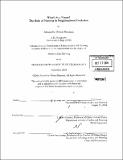| dc.contributor.advisor | J. Mark Schuster. | en_US |
| dc.contributor.author | Reitman, Alexandra Miriam, 1975- | en_US |
| dc.contributor.other | Massachusetts Institute of Technology. Dept. of Urban Studies and Planning. | en_US |
| dc.date.accessioned | 2005-09-27T18:22:47Z | |
| dc.date.available | 2005-09-27T18:22:47Z | |
| dc.date.copyright | 2004 | en_US |
| dc.date.issued | 2004 | en_US |
| dc.identifier.uri | http://hdl.handle.net/1721.1/28794 | |
| dc.description | Thesis (M.C.P.)--Massachusetts Institute of Technology, Dept. of Urban Studies and Planning, 2004. | en_US |
| dc.description | Includes bibliographical references (p. 131-138). | en_US |
| dc.description.abstract | (cont.) press (newspapers and magazines) was used to both gauge awareness as well as to evaluate whether and how the neighborhood image was projected in the media. Official policy and planning documents were also evaluated including zoning actions, Environmental Impact Statements, and landmark designation materials. | en_US |
| dc.description.abstract | Many cities have seen neighborhoods undergo successful revitalization in conjunction with the introduction of a new name. This thesis attempts to understand the role of neighborhood naming as a tool of planning and development, and investigates under what circumstances naming might be used to induce change in a neighborhood. The research question has been placed in the context of recent scholarship on place naming, the construction of social and political identity, the role of image in identity construction, marketing, branding, city imaging, and the tools of government. Recommendations are offered on how a neighborhood name might be used as a tool in planning and development, conditions for the successful introduction of a new neighborhood name, and circumstances that will increase the likelihood of inducing broader changes within a neighborhood via naming. Three case studies of neighborhood naming are presented: DUMBO (Down Under the Manhattan Bridge Overpass) in Brooklyn; Hudson Yards, also known as Hell's Kitchen South, on the far West Side of Manhattan; and the Ladder District, in Boston's Downtown Crossing neighborhood. All three were once active parts of their respective cities but for various reasons had fallen into decline. To varying degrees of success, each has recently introduced a new name in an attempt to reinvent itself as a desirable place to live, work, and spend leisure time. The history and experience of each neighborhood with respect to naming was investigated via primary and secondary sources of research. Qualitative interviews were conducted with stakeholders that represented key actors in each case, including community leaders, developers, local businesses, and city planning officials. Content analysis of local and regional | en_US |
| dc.description.statementofresponsibility | by Alexandra Miriam Reitman. | en_US |
| dc.format.extent | 145 p. | en_US |
| dc.format.extent | 11804327 bytes | |
| dc.format.extent | 11823684 bytes | |
| dc.format.mimetype | application/pdf | |
| dc.format.mimetype | application/pdf | |
| dc.language.iso | en_US | |
| dc.publisher | Massachusetts Institute of Technology | en_US |
| dc.rights | M.I.T. theses are protected by copyright. They may be viewed from this source for any purpose, but reproduction or distribution in any format is prohibited without written permission. See provided URL for inquiries about permission. | en_US |
| dc.rights.uri | http://dspace.mit.edu/handle/1721.1/7582 | |
| dc.subject | Urban Studies and Planning. | en_US |
| dc.title | What's in a name? : the role of naming in neighborhood evolution | en_US |
| dc.type | Thesis | en_US |
| dc.description.degree | M.C.P. | en_US |
| dc.contributor.department | Massachusetts Institute of Technology. Department of Urban Studies and Planning | |
| dc.identifier.oclc | 60249615 | en_US |
